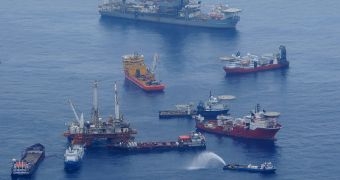Since April 20, thousands of barrels of crude have been spilling into the Gulf of Mexico from the site of the Deepwater Horizon drilling rig. After the platform sunk, on April 22, a massive spill ensued, and researchers have been unable to determine precisely how much oil was pouring out of the three exposed wellheads. At first, some believed about 1,000 barrels of oil were eliminated daily, but that number was later upped to at least 5,000. Now, the Flow Rate Technical Group (FRTG), which is based at the National Incident Command (NIC), provides a new estimate of how much oil is spilling daily.
Experts with the FRTG emphasized in their new report that the US Administration had, throughout this crisis, responded with all resources at its disposal, regardless of the initially-estimated flow rates. The Group was established by NIC Commander Admiral Thad Allen, and is chaired by the director of the US Geological Services (USGS), Dr Marcia McNutt. The expert adds that the worst-case scenario was always kept in mine while designing and implementing clean-up measures.
The FRTG used three separate methodologies to conduct its initial assessment of oil flow rates. The independent analysis has revealed that the lower and upper boundaries for these rates are situated between 12,000 and 19,000 barrels of oil per day, from all three wellheads. There were numerous factors preventing the accurate estimation of damages, including the environment and depth of the locations, the limited visibility in the area, the unique nature of the flow itself, as well as the limited access possibilities to the wellheads.
According to the Mass Balance team at FRTG, between 130,000 and 270,000 barrels of oil currently lie on the surface of the Gulf of Mexico, with additional amounts probably concentrated in vast, underwater plumes. The conclusion is based on datasets collected with an advanced observations tool called the Airborne Visible InfraRed Imaging Spectrometer (AVIRIS), which can be placed on various aircrafts. The instrument was previously used for finding water on the Moon, and this was the first instance in which it was used to look at oil slicks, the US Department of Interior (DoI) reports.
The Plume Modeling Team, which used computer simulations and video observations of the oil/gas mixture to produce its assessments, reported that between 12,000 to 25,000 barrels of oil are spilling into the Gulf daily. The team managing the Riser Insertion Tube Tool (RITT) provided checks for the other two groups. In a study conducted on May 25, the initiative found that 8,000 barrels of oil were being eliminated per day. The lower bound estimate of the total oil flow was determined to be at least 11,000 barrels, after taking into account other factors.

 14 DAY TRIAL //
14 DAY TRIAL //